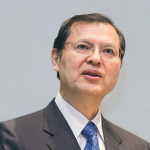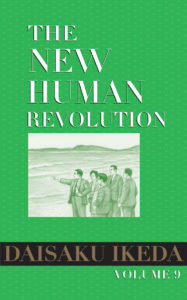 In the first chapter of volume 9, “A New Era,” Shin’ichi Yamamoto announces his decision to begin writing The Human Revolution at the seventh memorial (sixth anniversary) of second Soka Gakkai President Josei Toda’s death, in April 1964. The last chapter, “Hope of the People,” describes the scene when he actually starts work on the novel in Okinawa, on December 2, 1964.
In the first chapter of volume 9, “A New Era,” Shin’ichi Yamamoto announces his decision to begin writing The Human Revolution at the seventh memorial (sixth anniversary) of second Soka Gakkai President Josei Toda’s death, in April 1964. The last chapter, “Hope of the People,” describes the scene when he actually starts work on the novel in Okinawa, on December 2, 1964.
In “Hope of the People,” Shin’ichi recalls four milestones on the path that led him to resolve to document his mentor’s life.
The first occurred three months after he had joined the Soka Gakkai, when, deeply inspired to have met Toda, whom he described as “such an outstanding leader,”[1] he resolved to leave a record of his esteemed mentor’s life for posterity. Over the years, as he gave himself completely to struggling alongside Mr. Toda, that passionate resolve grew into an unshakable vow.
The second memory was of Mr. Toda showing him the manuscript of his own novel, Human Revolution, which was to be serialized in the Seikyo Shimbun, the Soka Gakkai’s daily newspaper, under the pen name, Myo Goku. The third was of a visit to Mr. Toda’s hometown of Atsuta, Hokkaido, and the last was a trip to Karuizawa in Nagano Prefecture with Mr. Toda in August 1957, just eight months before he passed away.
These four events took place between 1947 and 1957, when Shin’ichi was 19 to 29 years of age. During this period, he studied under Mr. Toda and advanced along the true path of mentor and disciple, regarding his far-ranging guidance and instructions as golden and eternal guidelines not merely for the present, but for the time after his mentor’s death. Thus, he was determined to record the great achievements of Mr. Toda, including all the guidance he received from him, through The Human Revolution.
Shin’ichi was keenly aware just how painfully challenging a task the serialization was going to be. Nonetheless, he was filled with joy and a sense of mission to be responsible for accurately recording the truth about Mr. Toda’s life and thoughts.
Precisely because of this unshakable vow, we are also able to study and advance on the Soka path of mentor and disciple today.
Strong Prayer Gives Rise to Wisdom
Many scenes from the “Young Phoenixes” chapter overlap with my own memories from when I was of future division age. At the time, there were an increasing number of second-generation members in the Soka Gakkai, including myself, and one of the big issues was how to teach the basics of faith and practice to a younger generation.
A white paper on youth [published by the Japanese government in 1964] noted that juvenile crime was rising sharply by the year and that there was a particular increase among a younger age bracket.
In this social context, Shin’ichi keenly recognizes the importance of nurturing young people and considers it the mission of the Soka Gakkai to demonstrate a positive example in society. With this intention, he establishes the junior high and high school divisions. He makes various arrangements to nurture and encourage the precious young people who will shoulder responsibility for the future, declaring:
If we don’t plant saplings, trees will not grow … We mustn’t let a good opportunity slip away. Also, we must be extra careful at the time of planting, paying attention to every detail.[2]
A youth division leader comments: “Your endless flow of ideas never ceases to amaze and impress me. How do you do it?”[3] Shin’ichi responds:
It’s a matter of being in earnest. I am always earnestly thinking about the 21st century … Our strong and focused prayer takes shape as wisdom, which in turn produces all sorts of ideas. Our sense of responsibility is manifest in the strength of that prayer.[4]
This passage reflects the fundamental attitude required not only for future division leaders, but all Soka Gakkai leaders.
At a meeting, Shin’ichi calls on the members of the high school division, speaking in a concrete and easily comprehensible manner:
It is important that you now chant Nam-myoho-renge-kyo diligently and always make study your top priority. Please don’t do anything to cause trouble to your parents or make them worry.[5]
On another occasion, he encourages the members:
Today, I have planted the seed of growth and development within your lives. But unless you have strong determination and are committed to fulfilling your great mission, that seed will not sprout and bear fruit.[6]
With his gaze firmly set on the future, Shin’ichi continuously inspires young successors. No matter how times may change, let us engrave in our hearts that only through such sincere and all-out encouragement can we transmit faith to the younger generation.
Vertical and Horizontal Expansion
Volume 9 chronicles various events that took place at the start of the “essential phase” of the Soka Gakkai’s development, including the establishment of the groups that are now known as the future division, to create a new current in the kosen-rufu movement toward the 21st century.
At the end of the “Young Phoenixes” chapter, President Ikeda writes:
At the start of the essential phase of kosen-rufu, President Yamamoto excavated fresh springs of capable people for the future by establishing the high school, junior high and elementary school divisions. This further expanded the flow of the great river of the next generation of Soka Gakkai leaders, and brought into view the broad horizon of the 21st century.[7]
Moreover, in regard to his commitment to fostering the future division, Shin’ichi says to the general director: “In another 30 or 40 years, the significance of what I’m doing now will become clear.”[8]
This volume was published in book form in Japanese on February 11, 2001, the 101st anniversary of President Toda’s birth. It was the first volume of The New Human Revolution to be published as a book in the 21st century. At the time, we were striving vigorously to advance the cause of kosen-rufu by expanding a “network of peace and humanity.” Studying volume 9, especially the “Hope of the People” chapter, enabled us to confirm our understanding of our mission to build a better society as Buddhist practitioners.
Moreover, on May 3, 2001, the Soka Gakkai launched the second series of Seven Bells[9] and commenced its advance toward its 100th anniversary in 2030.
In the “Brilliant Light” chapter, Shin’ichi explains:
The network of kosen-rufu must expand both horizontally and vertically. The horizontal expansion is the spread of an understanding of Buddhism from friend to friend. The vertical expansion is the transmission of faith from parent to child, from one generation to the next.[10]
As we advance toward the centennial of the Soka Gakkai’s founding, both the horizontal expansion of spreading an understanding of the Soka Gakkai with friends and in our communities, and the vertical expansion of transmitting faith to younger generations, will become increasingly important.
Later in the chapter, Shin’ichi states:
The 20th century has been called the century of war and revolution, but it is also the century that has seen the start of the human revolution. In fact, precisely because it has given birth to the human revolution, I am convinced that the twentieth century will go down in history as the prelude to the most glorious, brilliant century of life.[11]
It is up to each of us to make the twenty-first century a brilliant century of life. With the joy of bearing such a profound mission, let us challenge ourselves to do our own human revolution and expand our network of peace and humanity.
Translated from the June 25, 2019, issue of the Seikyo Shimbun, the Soka Gakkai’s daily newspaper.
Summary of Contents
 A New Era
A New Era
In May 1964, Shin’ichi Yamamoto visits Australia as part of an overseas tour, marking the first step in the “essential phase” of the Soka Gakkai.
Young Phoenixes
Prioritizing the development of the youngest members, whom he calls “young phoenixes,” Shin’ichi establishes the elementary, junior high and high school divisions.
Brilliant Light
Shin’ichi pays his first visit to Eastern Europe, observing firsthand the contradictions posed by totalitarian systems that lead to the oppression of the people.
Hope of the People
The Komei Party is launched. Shin’ichi starts to write the serialized novel The Human Revolution in Okinawa.
This book is available at https://bookstore.sgi-usa.org.
References
- The New Human Revolution, vol. 9, p. 283. ↩︎
- Ibid., p. 100. ↩︎
- Ibid., p. 109. ↩︎
- Ibid. ↩︎
- Ibid., p. 123. ↩︎
- Ibid., p. 151. ↩︎
- Ibid., p. 171. ↩︎
- Ibid., p. 100. ↩︎
- Seven Bells: The first series of Seven Bells consisted of seven consecutive seven-year periods in the Soka Gakkai’s development from its founding in 1930 through 1979. On May 3, 1958, shortly after second Soka Gakkai President Josei Toda’s death (on April 2), SGI President Ikeda, then Soka Gakkai youth division chief of staff, introduced this idea and announced targets for subsequent seven-year periods. On May 3, 1966, he spoke of a new series of Seven Bells that he envisaged unfolding in the twenty-first century. Later, he elaborated further on this second series, stating that it would begin from May 3, 2001, and continue through 2050. ↩︎
- The New Human Revolution, vol. 9, p. 196. ↩︎
- Ibid., p. 237. ↩︎
You are reading {{ meterCount }} of {{ meterMax }} free premium articles

